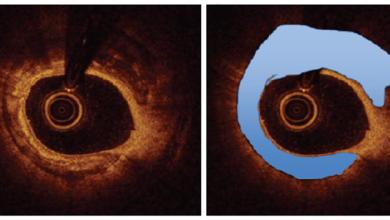Search results
PROMOTED
Author(s):
Nicolas M Van Mieghem
,
Kendra J Grubb
,
David Hildick-Smith
,
et al
Start date:
Mar 26, 2024
Author(s):
Luca Longobardo
,
Alessio Mattesini
,
Serafina Valente
,
et al
Added:
3 years ago
Coronary artery bifurcation lesions are treated in 15–20% of percutaneous coronary intervention (PCI) procedures and are still plagued by worse outcomes.1 This is in spite of recent significant advancements in stent technology in general and in bifurcation stenting techniques in particular. Conventional angiography provides only limited information about bifurcation anatomy, plaque distribution…
View more
Author(s):
Shao-Liang Chen
,
Imad Sheiban
Added:
3 years ago
Bifurcation lesions account for approximately 20–30% of all percutaneous coronary interventions (PCIs). Coronary bifurcation sites are prone to developing obstructive atherosclerotic disease due to turbulent blood flow and change of shear stress. With the complexity of bifurcation lesions, several classification systems have been advocated in order to extablish percutaneous strategies.1–3 In fact…
View more
Author(s):
Helen Routledge
Added:
3 years ago
The preferred treatment approach for bifurcation disease can be generally summed up as ‘keep it simple’, otherwise known as provisional stenting. Based on several contemporary studies, coronary interventionalists have settled on a minimalist approach: starting with a single-stent approach for the main vessel (MV) and ignoring side branch (SB) disease unless clinical circumstances warrant…
View more
Author(s):
Nicolas Foin
,
Eduardo Alegria-Barrero
,
Ryo Torii
,
et al
Added:
3 years ago
Drug-eluting stents (DESs) have contributed to a significant lowering of the incidence of restenosis and target vessel revascularisation (TVR) in bifurcations.1–4 A randomised study of bifurcation lesions using sirolimus-eluting stents revealed restenosis rates of only 4 % in the main branch (MB) and a TVR rate as low as 8.2 % at six-month follow-up,2 a marked improvement over that in historical…
View more
Author(s):
Goran Stankovic
,
Zlatko Mehmedbegovic
,
Milorad Zivkovic
Added:
3 years ago
Approximately 15–20% of percutaneous coronary interventions (PCIs) are performed to treat coronary bifurcations. These procedures are renowned for being technically challenging and historically have been associated with lower procedural success rates and worse clinical outcomes compared with non-bifurcation lesions.1,2
A bifurcation lesion is a lesion occurring at, or adjacent to, a significant…
View more
Author(s):
Yves Louvard
,
Marie-Claude Morice
,
Thomas Hovasse
,
et al
Added:
3 years ago
Due to anatomical reasons and the distributive function of the coronary tree, bifurcation sites are prone to the development of atherosclerotic lesions as a result of flow turbulence generating pro-atherogenous low wall shear stress (WSS). Over the past few years, coronary bifurcation lesions have been the subject of intense therapeutic discussions fuelled by new definitions, classifications …
View more
Author(s):
Angela Hoye
,
Scot Garg
Added:
3 years ago
Coronary artery bifurcations are at an increased risk of the development of coronary atherosclerosis because of turbulent flow and low shear stress. Bifurcation lesions account for between 8% and 22% of all percutaneous coronary interventions (PCI) and have long posed a problem for interventional cardiologists.
Published data show bifurcation lesions treated using bare metal stents (BMS) have…
View more
Author(s):
Evan Shlofmitz
,
Allen Jeremias
,
Richard A Shlofmitz
,
et al
Added:
3 years ago
Coronary calcification has posed challenges to successful revascularisation since the development of percutaneous coronary intervention (PCI).1 Coronary artery calcification worsens clinical outcomes irrespective of the revascularisation strategy.2–4 Despite significant improvements in stent design over the past decades, including an improved ability to deliver a stent, severe calcification…
View more
Left Main Bifurcation Live Case Series
Added:
3 years ago
Video Series













